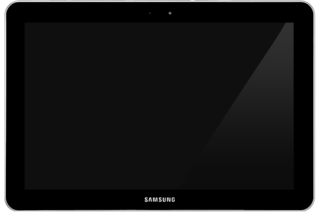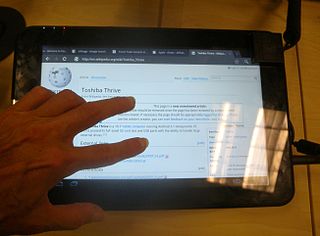Related Research Articles

Tegra is a system on a chip (SoC) series developed by Nvidia for mobile devices such as smartphones, personal digital assistants, and mobile Internet devices. The Tegra integrates an ARM architecture central processing unit (CPU), graphics processing unit (GPU), northbridge, southbridge, and memory controller onto one package. Early Tegra SoCs are designed as efficient multimedia processors. The Tegra-line evolved to emphasize performance for gaming and machine learning applications without sacrificing power efficiency, before taking a drastic shift in direction towards platforms that provide vehicular automation with the applied "Nvidia Drive" brand name on reference boards and its semiconductors; and with the "Nvidia Jetson" brand name for boards adequate for AI applications within e.g. robots or drones, and for various smart high level automation purposes.

A smartbook was a class of mobile device that combined certain features of both a smartphone and netbook computer, produced between 2009 and 2010. Smartbooks were advertised with features such as always on, all-day battery life, 3G, or Wi-Fi connectivity and GPS in a laptop or tablet-style body with a screen size of 5 to 10 inches and a physical or soft touchscreen keyboard.
Google Nexus is a discontinued line of consumer electronic devices that run the Android operating system. Google managed the design, development, marketing, and support of these devices, but some development and all manufacturing were carried out by partnering with original equipment manufacturers (OEMs). Alongside the main smartphone products, the line also included tablet computers and streaming media players; the Nexus started out in January 2010 and reached its end in October 2016, replaced by Google Pixel.

The Nook Color is a tablet computer/e-reader that was marketed by Barnes & Noble. A 7-inch (18 cm) tablet with multitouch touchscreen input, it is the first device in the Nook line to feature a full-color screen. The device is designed for viewing of books, newspapers, magazines, and children's picture books. A limited number of the children's books available for the Nook Color include interactive animations and the option to have a professional voice actor read the story. It was announced on 26 October 2010 and shipped on 16 November 2010. Nook Color became available at the introductory price of US$249. In December 2011, with the release of the Nook Tablet, it lowered to US$169. On 12 August 2012, the price lowered to US$149. On 4 November 2012, the price was further lowered to US$139. The tablet ran on Android.

The ViewSonic G Tablet is an Android-based tablet produced by ViewSonic Corporation, a manufacturer and provider of visual technology. It first appeared for consumer purchase at Sears on 1 November 2010.
Project Denver is the codename of a central processing unit designed by Nvidia that implements the ARMv8-A 64/32-bit instruction sets using a combination of simple hardware decoder and software-based binary translation where "Denver's binary translation layer runs in software, at a lower level than the operating system, and stores commonly accessed, already optimized code sequences in a 128 MB cache stored in main memory". Denver is a very wide in-order superscalar pipeline. Its design makes it suitable for integration with other SIPs cores into one die constituting a system on a chip (SoC).

The Asus Eee Pad Transformer TF101 is a 2-in-1 detachable tablet developed by Asus that runs the Android operating system. It is the first tablet in the Asus Transformer Pad series. The Eee Pad Transformer features a 10.1-inch (260 mm) display, an Nvidia Tegra 2 dual-core chip, 1 GB of RAM, and 16 or 32 GB of storage. The tablet initially launched with Android 3.1, nicknamed "Honeycomb", but was updated to support Android 4.0.3.

Introduced in 2011, the Samsung Galaxy Tab 10.1 is an Android-based tablet computer designed and manufactured by Samsung. It is part of the Samsung Galaxy Tab series, and features a 10.1-inch (260 mm) display and a 1 GHz dual-core Nvidia Tegra 2 processor.

The Toshiba Thrive was a 10.1" tablet computer running Android 3.2.1. PC World praised its full-sized and versatile SD card slot, HDMI port, and USB ports with host functionality and the ability to handle large external drives as well as standard peripherals like USB Keyboards, printers and cameras. The review concluded that there were minor disadvantages including a bulky form and poor sound quality. CNET's review said "Its grooved back, full HDMI and USB support, full SD card slot, and replaceable battery justify its very bulky design."

The LG Optimus Pad is a tablet computer developed by LG Electronics for its own line-up and for specific mobile carriers in selected countries. Mobile carries include NTT DoCoMo and T-Mobile which unlike its domestic rival, Samsung offering the same tablet model for specific carriers, LG does not alter the specs of those they release to these carriers and the only alteration is on the addition of the mobile carriers logo on it. The LG Optimus Pad was first released in South Korea in April 2011 and then in the US in March 2011 which is also known as the T-Mobile G-Slate. It is LG's first device running Android 3.0 ("Honeycomb") and appeared at the Mobile World Congress in February 2011.

The Samsung Galaxy Tab 8.9 is an Android-based tablet computer designed and manufactured by Samsung, introduced on 22 March 2011 at CTIA wireless convention in its Samsung Unpacked event in Orlando. It is part of the Samsung Galaxy Tab series, and features an 8.9-inch display and a 1 GHz dual-core Nvidia Tegra 2 processor.
The Acer Iconia A500 is a tablet computer designed, developed and marketed by Acer Inc. The A500 launched with the Android Honeycomb operating system which is now upgradable to Ice Cream Sandwich 4.0.3. The tablet is also sold in almost identical form as the Packard Bell Liberty Tab G100.
The Acer Iconia is a range of tablet computers from Acer Inc. of Taiwan.
The Samsung Galaxy R (Royal) (GT-I9103) is an Android smartphone that was announced by Samsung on August 10, 2011 as a variant to the Samsung Galaxy S II.

The Asus Eee Pad Transformer TF201 or Asus Eee Pad Transformer Prime is a 2-in-1 detachable tablet from the Asus Transformer Pad series. It is the world's first Android tablet computer with a quad-core processor, and a successor to the dual-core Asus Eee Pad Transformer. It runs Android 4.1. The Transformer Prime was announced by Asus on 9 November 2011. It was released in Taiwan on 1 December 2011, and in Canada and the United States during the week of 19 December 2011.

The Tablet S is a tablet computer released by Sony in September 2011. Featuring a "unique asymmetric design", the Tablet S runs Google's Android 3.2 Honeycomb operating system and features a 9.4 in (240 mm) multitouch display, 1 GHz Nvidia Tegra 2 dual core processor, Wi-Fi ability, front- and rear-facing cameras, Bluetooth, and an infrared sensor. It is also configured with access to the Sony Entertainment Network and is PlayStation Certified and DLNA compatible. Tablet S was Sony's first modern tablet computer. It was succeeded by the Xperia Tablet S, which would be created by Sony's new subsidiary Sony Mobile.
The IdeaPad tablets from Lenovo were a brand of consumer-oriented tablet computers designed for home use or entertainment, as opposed to the business-focused ThinkPad Tablet series. Devices sold in certain countries, such as China, India and New Zealand, were sold under the LePad brand, similar to the LePhone series of smartphones. IdeaPad-branded tablets have been produced with the Android and Windows operating systems.

The Nvidia Shield TV is an Android TV-based digital media player produced by Nvidia as part of its Shield brand of Android devices. First released in May 2015, the Shield was initially marketed by Nvidia as a microconsole, emphasizing its ability to play downloaded games and stream games from a compatible PC on a local network, or via the GeForce Now subscription service. As with all other Android TV devices, it can also stream content from various sources using apps, and also supports 4K resolution video. It is produced in two models, with the second Shield TV Pro model distinguished primarily by increased internal storage.
The Pixel C is a 10.2-inch (260 mm) Android tablet developed and marketed by Google. The device was unveiled during a media event on September 29, 2015. On October 9, 2018, it was succeeded by the Pixel Slate.

The Xiaomi Mi Pad is a tablet computer produced by Xiaomi. It is Xiaomi's first tablet and is manufactured by Foxconn. The device is available in two storage sizes, 16 GB and 64 GB.
References
- ↑ Notion Ink Shipping Date
- ↑ (Order Page) Archived December 23, 2010, at the Wayback Machine
- ↑ Notion INK Announcement
- ↑ "Guest Post: ICS Team". wordpress.com. 11 February 2012. Retrieved 14 April 2018.
- ↑ "Next Round of Order". wordpress.com. 9 February 2011. Retrieved 14 April 2018.
- 1 2 3 Notion Ink Features Archived December 23, 2010, at the Wayback Machine
- ↑ "Notion Ink Adam tablet: The Post-CES Primer". Archived from the original on 2011-01-13. Retrieved 2011-01-11.
- ↑ "Camera and More". wordpress.com. 7 April 2012. Retrieved 14 April 2018.
- ↑ "Notion Ink Adam tablet shipping delayed". notebookcheck.net. February 2011. Retrieved 14 April 2018.
- ↑ "Notion ink Adam Bricked with over the air update". goodereader.com. 25 January 2011. Retrieved 14 April 2018.
- ↑ "Notion Ink Adam display neither matte nor scratch-resistant?". SlashGear. 16 January 2011.
- ↑ "Digital News: LongBox launches on ADAM; goes to v. 1.1". comicsbeat.com. 12 October 2010. Retrieved 14 April 2018.
- ↑ Thomas Ricker, "Notion Ink Adam hits the FCC, torn apart in haste", 28 January 2011
- ↑ "More Updates". wordpress.com. 28 January 2011. Retrieved 14 April 2018.
- ↑ "Our Hands-On With The Notion Ink Adam Tablet – TechCrunch". www.crunchgear.com. Archived from the original on 17 March 2011. Retrieved 14 April 2018.
- ↑ "Exclusive: Notion Adam Ink Secret Feature Revealed". crunchgear.com. Archived from the original on 10 January 2011. Retrieved 14 April 2018.
- ↑ notionaddicts.com. "CrunchGear Interview with Notion Ink at CES 2011". Archived from the original on 2011-01-10. Retrieved 2011-01-08.
- ↑ Week-End Special – XI « Notion Ink
- ↑ FIAT LUX! « Notion Ink
- ↑ Adam Tablet Review http://techblog.aasisvinayak.com/apples-ipad-vs-notion-inks-adam/ Archived 2010-02-24 at the Wayback Machine
- ↑ "Introducing Eden – II". wordpress.com. 21 December 2010. Retrieved 14 April 2018.
- ↑ "Introducing Eden – III". wordpress.com. 22 December 2010. Retrieved 14 April 2018.
- ↑ "Calendar Application". wordpress.com. Retrieved 14 April 2018.
- ↑ "Introducing Eden – V The Browser". wordpress.com. 26 December 2010. Retrieved 14 April 2018.
- ↑ "Weather Application". wordpress.com. Retrieved 14 April 2018.
- ↑ "Music Panel". wordpress.com. Retrieved 14 April 2018.
- ↑ "Music Application". wordpress.com. Retrieved 14 April 2018.
- 1 2 Week End Special ix
- ↑ "E-Reader Application". wordpress.com. Retrieved 14 April 2018.
- ↑ "Introducing Eden – IV". wordpress.com. 23 December 2010. Retrieved 14 April 2018.
- ↑ Johnston, Rich (October 9, 2010). "Bleeding Cool Talks With Rantz Hoseley About Longbox". Bleeding Cool. Archived from the original on 10 October 2010. Retrieved October 10, 2010.
- ↑ Shravan, Rohan (May 28, 2011). "Here we are". Notion Ink Blog. Archived from the original on 28 June 2011. Retrieved May 28, 2011.
- ↑ Shravan, Rohan (May 30, 2011). "We are Live Again". Notion Ink Blog. Archived from the original on 29 June 2011. Retrieved May 30, 2011.